Lobster Supply Chains Are Not at Risk from Paralytic Shellfish Toxin Accumulation during Wet Storage
Abstract
1. Introduction
2. Results
2.1. Stocking Animals
2.2. Specific Feed Intake
2.3. PST Accumulation
2.4. Lobster Health Responses
2.5. Behavioural Responses
2.6. Immune Health Response
2.7. Nutritional Response
2.8. Haemolymph Biochemical Response
2.9. Histopathological Findings in Gills
3. Discussion
4. Materials and Methods
4.1. Experimental System
4.2. Algal Cultures
4.3. Lobster Treatments
4.4. Specific Feed Intake
4.5. Lobster Harvest Protocols
4.6. Behavioural Responses
4.7. Immune Health Response
4.8. Nutritional Health Response
4.9. Haemolymph Biochemical Response
4.10. PST Analysis
4.11. Gill Histology
4.12. Data Analysis
Supplementary Materials
Author Contributions
Funding
Institutional Review Board Statement
Informed Consent Statement
Data Availability Statement
Acknowledgments
Conflicts of Interest
References
- Patterson, H.; Williams, A.; Woodhams, J.; Curtotti, R. Fishery Status Reports 2019; Australian Bureau of Agricultural and Resource Economics: Canberra, Australia, 2019.
- Williams, J.; Stokes, F.; Dixon, H.; Hurren, K. The Economic Contribution of Commercial Fishing to the New Zealand Economy; BERL: Wellington, New Zealand, 2017; pp. 1–53.
- Condie, S.A.; Oliver, E.C.J.; Hallegraeff, G.M. Environmental drivers of unprecedented Alexandrium catenella dinoflagellate blooms off eastern Tasmania, 2012–2018. Harmful Algae 2019, 87, 101628. [Google Scholar] [CrossRef] [PubMed]
- Hallegraeff, G.; Bolch, C.; Condie, S.; Dorantes-Aranda, J.J.; Murray, S.; Quinlan, R.; Ruvindy, R.; Turnbull, A.; Ugalde, S.; Wilson, K. Unprecedented Alexandrium blooms in a previously low biotoxin risk area of Tasmania, Australia. In Proceedings of the 17th International Conference on Harmful Algae 2016; International Society for the Study of Harmful Algae and Intergovernmental Oceanographic Commission of UNESCO: Paris, France, 2017; pp. 38–41. [Google Scholar]
- MacKenzie, A.L. The risk to New Zealand shellfish aquaculture from paralytic shellfish poisoning (PSP) toxins. New Zealand J. Mar. Freshw. Res. 2014, 48, 430–465. [Google Scholar] [CrossRef]
- Rhodes, L.; Smith, K.F.; MacKenzie, L.; Wood, S.A.; Ponikla, K.; Harwood, D.T.; Packer, M.; Munday, R. The Cawthron Institute Culture Collection of Micro-algae: A significant national collection. New Zealand J. Mar. Freshw. Res. 2016, 50, 291–316. [Google Scholar] [CrossRef]
- Madigan, T.; Malhi, N.; Tan, J.; McLeod, C.; Stewart, I.; Harwood, T.; Mann, G.; Turnbull, A. Experimental uptake and depuration of paralytic shellfish toxins in Southern Rock Lobster, Jasus edwardsii. Toxicon 2018, 143, 44–50. [Google Scholar] [CrossRef] [PubMed]
- Turnbull, A.; Malhi, N.; Seger, A.; Harwood, T.; Jolley, J.; Fitzgibbon, Q.; Hallegraeff, G. Paralytic shellfish toxin uptake, tissue distribution, and depuration in the Southern Rock Lobster Jasus edwardsii Hutton. Harmful Algae 2020, 95, 101818. [Google Scholar] [CrossRef]
- McLeod, C.; Kiermeier, A.; Stewart, I.; Tan, J.; Turnbull, A.; Madigan, T. Paralytic shellfish toxins in Australian Southern Rock Lobster (Jasus edwardsii): Acute human exposure from consumption of hepatopancreas. Hum. Ecol. Risk Assess. 2018, 24, 1872. [Google Scholar] [CrossRef]
- Patel, K.K.; Fitzgibbon, Q.; Caraguel, C.G.B. Investigation of risk factors associated with sub-optimal holding survival in southern rock lobster (Jasus edwardsii) in Australia. Prev. Vet. Med. 2020, 183, 105122. [Google Scholar] [CrossRef]
- Henry, R.P.; Lucu, C.; Onken, H.; Weihrauch, D. Multiple functions of the crustacean gill: Osmotic/ionic regulation, acid-base balance, ammonia excretion, and bioaccumulation of toxic metals. Front. Physiol. 2012, 3, 431. [Google Scholar] [CrossRef]
- Stoner, A.W. Assessing stress and predicting mortality in economically significant crustaceans. Rev. Fish. Sci. 2012, 20, 111–135. [Google Scholar] [CrossRef]
- Turnbull, A.; Malhi, N.; Seger, A.; Jolley, J.; Hallegraeff, G.; Fitzgibbon, Q. Accumulation of paralytic shellfish toxins by Southern Rock Lobster Jasus edwardsii causes minimal impact on lobster health. Aquat. Toxicol. 2020. [Google Scholar] [CrossRef]
- Dorantes-Aranda, J.J.; Seger, A.; Mardones, J.I.; Nichols, P.D.; Hallegraeff, G.M. Progress in understanding algal bloom-mediated fish kills: The role of superoxide radicals, phycotoxins and fatty acids. PLoS ONE 2015, 10, e0133549. [Google Scholar] [CrossRef]
- Mardones, J.I.; Dorantes-Aranda, J.J.; Nichols, P.D.; Hallegraeff, G.M. Fish gill damage by the dinoflagellate Alexandrium catenella from Chilean fjords: Synergistic action of ROS and PUFA. Harmful Algae 2015, 49, 40–49. [Google Scholar] [CrossRef]
- Spanoghe, P.T.; Bourne, P.K. Relative influence of environmental factors and processing techniques on Panulirus cygnus morbidity and mortality during simulated live shipments. Mar. Freshw. Res. 1997, 48, 839–844. [Google Scholar] [CrossRef]
- James, P.; Izquierdo-Gómez, D.; Siikavuopio, S.I. Use of reflex indicators for measuring vitality and mortality of the snow crab (Chionoecetes opilio) in captivity. Aquac. Res. 2019, 50, 1321–1328. [Google Scholar] [CrossRef]
- Paterson, B.D.; Spanoghe, P.T.; Davidson, G.W.; Hosking, W.; Nottingham, S.; Jussila, J.; Evans, L.H. Predicting survival of western rock lobsters Panulirus cygnus using discriminant analysis of haemolymph parameters taken immediately following simulated handling treatments. New Zealand J. Mar. Freshw. Res. 2005, 39, 1129–1143. [Google Scholar] [CrossRef]
- Stoner, A.W.; Rose, C.S.; Munk, J.E.; Hammond, C.F.; Davis, M.W. An assessment of discard mortality for two Alaskan crab species, Tanner crab (Chionoecetes bairdi) and snow crab (C. opilio), based on reflex impairment. Fish. Bull. 2008, 106, 337. [Google Scholar]
- Stoner, A.W. Prediction of discard mortality for Alaskan crabs after exposure to freezing temperatures, based on a reflex impairment index. Fish. Bull. 2009, 107, 451. [Google Scholar]
- Day, R.D.; Fitzgibbon, Q.P.; Gardner, C. The impact of holding stressors on the immune function and haemolymph biochemistry of Southern Rock Lobsters (Jasus edwardsii). Fish Shellfish Immunol. 2019, 89, 660–671. [Google Scholar] [CrossRef] [PubMed]
- Fitzgibbon, Q.P.; Day, R.D.; McCauley, R.D.; Simon, C.J.; Semmens, J.M. The impact of seismic air gun exposure on the haemolymph physiology and nutritional condition of spiny lobster, Jasus edwardsii. Mar. Pollut. Bull. 2017, 125, 146–156. [Google Scholar] [CrossRef] [PubMed]
- Fotedar, S.; Evans, L.; Jones, B. Effect of holding duration on the immune system of western rock lobster, Panulirus cygnus. Comp. Biochem. Physiol. Part A 2006, 143, 479–487. [Google Scholar] [CrossRef]
- Fotedar, S.; Tsvetnenko, E.; Evans, L. Effect of air exposure on the immune system of the rock lobster Panulirus cygnus. Mar. Freshw. Res. 2001, 52, 1351–1355. [Google Scholar] [CrossRef]
- Simon, C.J.; Mendo, T.C.; Green, B.S.; Gardner, C. Predicting transport survival of brindle and red rock lobsters Jasus edwardsii using haemolymph biochemistry and behaviour traits. Comp. Biochem. Physiol. Part A 2016, 201, 101–109. [Google Scholar] [CrossRef]
- Tsvetnenko, E.; Fotedar, S.; Evans, L. Antibacterial activity in the haemolymph of western rock lobster, Panulirus cygnus. Mar. Freshw. Res. 2001, 52, 1407–1412. [Google Scholar] [CrossRef]
- Chandrapavan, A.; Gardner, C.; Green, B.S. Haemolymph condition of deep-water southern rock lobsters (Jasus edwardsii) translocated to inshore reefs. Mar. Freshw. Behav. Physiol. 2011, 44, 21–32. [Google Scholar] [CrossRef]
- Morris, S.; Oliver, S. Circulatory, respiratory and metabolic response to emersion and low temperature of Jasus edwardsii: Simulation studies of commercial shipping methods. Comp. Biochem. Physiol. A Mol. Integr. Physiol. 1999, 122, 299–308. [Google Scholar] [CrossRef]
- Travis, D.F. The moulting cycle of the spiny lobster, Panulirus argus Latreille. II. Pre-ecdysial histological and histochemical changes in the hepatopancreas and integumental tissues. Biol. Bull. 1954, 108, 88–112. [Google Scholar] [CrossRef]
- Seger, A.; Hallegraeff, G.; Stone, D.; Bansemer, M.; Harwood, T.D.; Turnbull, A. Uptake of paralytic shellfish toxins by blacklip abalone (Haliotis rubra rubra leach) from direct exposure to Alexandrium catenella microalgal cells and toxic aquaculture feed. Harmful Algae 2020, 99. [Google Scholar] [CrossRef] [PubMed]
- Supono, S.; Knowles, G.; Bolch, C. Toxicity and histopathological effects of toxic dinoflagellate, Alexandrium catenella exudates on larvae of blue mussel, Mytilus galloprovincialis, and Pacific oyster, Crassostrea gigas. J. Ilm. Perikan. Dan Kelaut. 2020, 12, 188–198. [Google Scholar] [CrossRef]
- Jester, R.; Rhodes, L.; Beuzenberg, V. Uptake of paralytic shellfish poisoning and spirolide toxins by paddle crabs (Ovalipes catharus) via a bivalve vector. Harmful Algae 2009, 8, 369–376. [Google Scholar] [CrossRef]
- Lilly, E.L.; Kulis, D.M.; Gentien, P.; Anderson, D.M. Paralytic shellfish poisoning toxins in France linked to a human-introduced strain of Alexandrium catenella from the western Pacific: Evidence from DNA and toxin analysis. J. Plankton Res. 2002, 24, 443–452. [Google Scholar] [CrossRef]
- Sekiguchi, K.; Ogata, T.; Kaga, S.; Yoshida, M.; Fukuyo, Y.; Kodama, M. Accumulation of paralytic shellfish toxins in the scallop Patinopecten yessoensis caused by the dinoflagellate Alexandrium catenella in Otsuchi Bay, Iwate Prefecture, northern Pacific coast of Japan. Fish. Sci. 2001, 67, 1157–1162. [Google Scholar] [CrossRef]
- Varela, D.; Paredes, J.; Alves-de-Souza, C.; Seguel, M.; Sfeir, A.; Frangópulos, M. Intraregional variation among Alexandrium catenella (Dinophyceae) strains from southern Chile: Morphological, toxicological and genetic diversity. Harmful Algae 2012, 15, 8–18. [Google Scholar] [CrossRef]
- Dorantes-Aranda, J.J.; Tan, J.Y.C.; Hallegraeff, G.M.; Campbell, K.; Ugalde, S.C.; Harwood, D.T.; Bartlett, J.K.; Campàs, M.; Crooks, S.; Gerssen, A.; et al. Detection of paralytic shellfish toxins in mussels and oysters using the qualitative Neogen Lateral-Flow Immunoassay: An interlaboratory study. J. AOAC Int. 2018, 101, 468–479. [Google Scholar] [CrossRef] [PubMed]
- Turnbull, A.R.; Tan, J.Y.C.; Ugalde, S.C.; Hallegraeff, G.M.; Campbell, K.; Harwood, D.T.; Dorantes-Aranda, J.J. Single-laboratory validation of the Neogen Qualitative Lateral Flow Immunoassay for the detection of paralytic shellfish toxins in mussels and oysters. J. AOAC Int. 2018, 101, 480–489. [Google Scholar] [CrossRef] [PubMed]
- Harwood, D.T.; Boundy, M.; Selwood, A.I.; van Ginkel, R.; MacKenzie, L.; McNabb, P.S. Refinement and implementation of the Lawrence method (AOAC 2005.06) in a commercial laboratory: Assay performance during an Alexandrium catenella bloom event. Harmful Algae 2013, 24, 20–31. [Google Scholar] [CrossRef]
- Castrec, J.; Soudant, P.; Payton, L.; Tran, D.; Miner, P.; Lambert, C.; Le Goïc, N.; Huvet, A.; Quillien, V.; Boullot, F.; et al. Bioactive extracellular compounds produced by the dinoflagellate Alexandrium minutum are highly detrimental for oysters. Aquat. Toxicol. 2018, 199, 188–198. [Google Scholar] [CrossRef] [PubMed]
- Chen, C.-Y.; Chou, H.-N. Ichthyotoxicity studies of milkfish Chanos chanos fingerlings exposed to a harmful dinoflagellate Alexandrium minutum. J. Exp. Mar. Biol. Ecol. 2001, 262, 211–219. [Google Scholar] [CrossRef]
- Ma, H.; Krock, B.; Tillmann, U.; Bickmeyer, U.; Graeve, M.; Cembella, A. Mode of action of membrane-disruptive lytic compounds from the marine dinoflagellate Alexandrium tamarense. Toxicon 2011, 58, 247–258. [Google Scholar] [CrossRef]
- Shimada, M.; Imahayashi, T.; Ozaki, H.S.; Murakami, T.H.; Toyoshima, T.; Okaichi, T. Effects of sea bloom, Chattonella antiqual, on gill primary lamellae of the young yellowtail, Seriola quinqueradiata. Acta Histochem. Cytochem. 1983, 16, 232–244. [Google Scholar] [CrossRef]
- Hallegraeff, G.; Dorantes-Aranda, J.; Mardones, J.I.; Seger, A. Review of progress in our understanding of fish-killing microalgae: Implications for management and mitigation. In Proceedings of the 17th International Conference on Harmful Algae 2016; International Society for the Study of Harmful Algae and Intergovernmental Oceanographic Commission of UNESCO: Paris, France, 2017; pp. 150–155. [Google Scholar]
- Roberts, R.J.; Bullock, A.M.; Turners, M.; Jones, K.; Tett, P. Mortalities of Salmo gairdneri exposed to cultures of Gyrodinium aureolum. J. Mar. Biol. Assoc. U.K. 1983, 63, 741–743. [Google Scholar] [CrossRef]
- Dove, A.D.M.; Allam, B.; Powers, J.J.; Sokolowski, M.S. A prolonged thermal stress experiment on the American Lobster Homarus americanus. J. Shellfish Res. 2005, 24, 761–765. [Google Scholar]
- Lorenzon, S.; Giulianini, P.G.; Martinis, M.; Ferrero, E.A. Stress effect of different temperatures and air exposure during transport on physiological profiles in the American lobster Homarus americanus. Comp. Biochem. Physiol. Part A Mol. Integr. Physiol. 2007, 147, 94–102. [Google Scholar] [CrossRef] [PubMed]
- Whiteley, E.; Taylor, E. Oxygen and acid-base disturbances in the hemolymph of the lobster Homarus gammarus during commercial transport and storage. J. Crustacean Biol. 1992, 12, 19–30. [Google Scholar] [CrossRef]
- Stewart, J.E.; Cornick, J.W.; Foley, D.M.; Li, M.F.; Bishop, C.M. Muscle weight relationship to serum proteins, hemocytes and hepatopancreas in the lobster, Homarus americanus. Fish. Res. Board Can. 1967, 24, 2339–2354. [Google Scholar] [CrossRef]
- Jussila, J.; Jago, J.; Tsvetnenko, E.; Dunstan, B.; Evans, L.H. Total and differential haemocyte counts in western rock lobsters (Panulirus cygnus George) under post-harvest stress. Mar. Freshw. Res. 1997, 48, 863–868. [Google Scholar] [CrossRef]
- Basti, D.; Hoyt, K.; Bouchard, D.; Bricknell, I.; Chang, E.S.; Halteman, W. Factors affecting post-capture survivability of lobster Homarus americanus. Dis. Aquat. Org. 2010, 90, 153–166. [Google Scholar] [CrossRef]
- Boundy, M.J.; Selwood, A.I.; Harwood, T.D.; McNabb, P.S.; Turner, A.D. Development of a sensitive and selective liquid chromatography–mass spectrometry method for high throughput analysis of paralytic shellfish toxins using graphitised carbon solid phase extraction. J. Chromatogr. A 2015, 1387, 1–12. [Google Scholar] [CrossRef]
- Turner, A.D.; McNabb, P.S.; Harwood, T.; Selwood, A.I.; Boundy, M.J. Single-laboratory validation of a multitoxin ultra-performance LC-hydrophilic interaction LC-MS/MS method for quantitation of paralytic shellfish toxins in bivalve shellfish. J. AOAC Int. 2015, 98, 609–621. [Google Scholar] [CrossRef]
- Fitzgibbon, Q.P.; Simon, C.J.; Smith, G.G.; Carter, C.G.; Battaglene, S.C. Temperature dependent growth, feeding, nutritional condition and aerobic metabolism of juvenile spiny lobster, Sagmariasus verreauxi. Comp. Biochem. Physiol. Part A Mol. Integr. Physiol. 2017, 207, 13–20. [Google Scholar] [CrossRef]
- Day, R.D.; McCauley, R.D.; Fitzgibbon, Q.P.; Hartmann, K.; Semmens, J.M. Seismic air guns damage rock lobster mechanosensory organs and impair righting reflex. Proc. R. Soc. B Biol. Sci. 2019, 286. [Google Scholar] [CrossRef]
- Simon, C.J.; Fitzgibbon, Q.P.; Battison, A.; Carter, C.G.; Battaglene, S.C. Bioenergetics of nutrient reserves and metabolism in spiny lobster juveniles Sagmariasus verreauxi: Predicting nutritional condition from hemolymph biochemistry. Physiol. Biochem. Zool. Ecol. Evol. Approaches 2015, 88, 266–283. [Google Scholar] [CrossRef] [PubMed]
- Landman, M.J.; Fitzgibbon, Q.P.; Wirtz, A.; Codabaccus, B.M.; Ventura, T.; Smith, G.G.; Carter, C.G. Physiological status and nutritional condition of cultured juvenile Thenus australiensis over the moult cycle. Comp. Biochem. Physiol. Part B Biochem. Mol. Biol. 2020, 250, 110504. [Google Scholar] [CrossRef] [PubMed]
- Food and Agriculture Organization of the United Nations and World Health Organisation. Technical Paper on Toxicity Equivalency Factors for Marine Biotoxins Associated with Bivalve Molluscs; FAO/WHO: Rome, Italy, 2016. [Google Scholar]
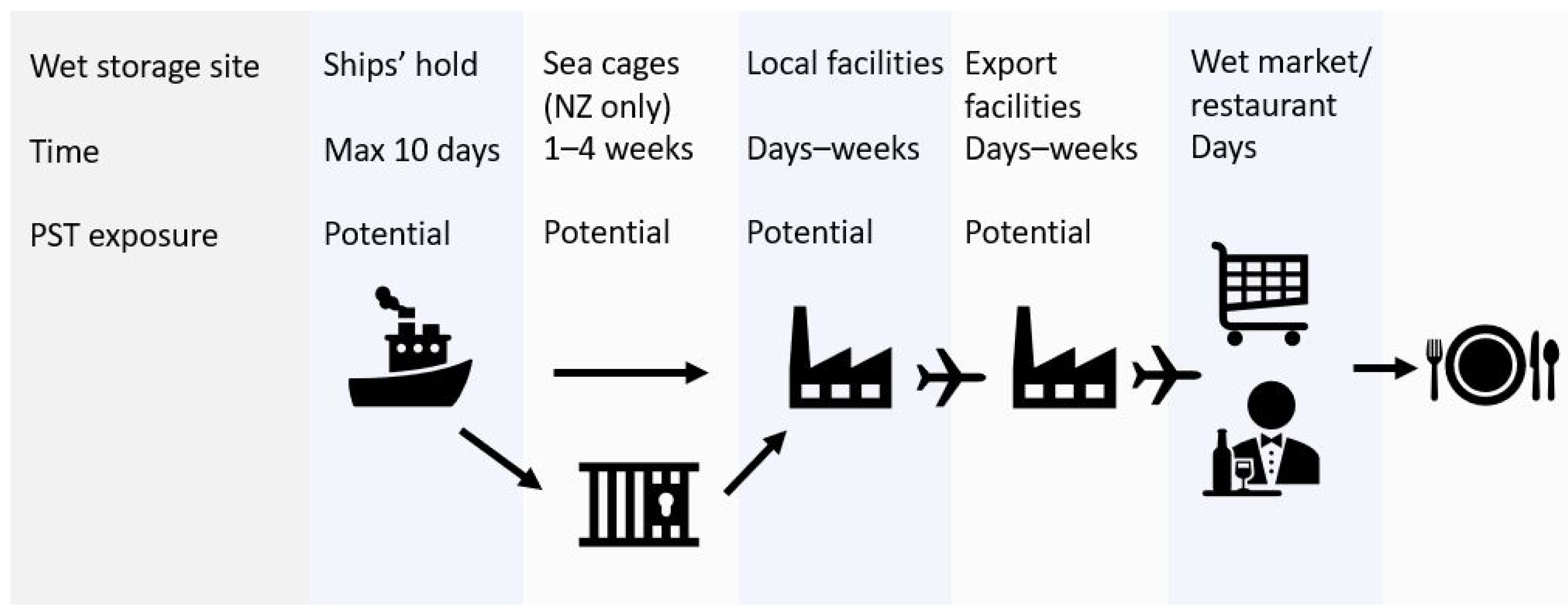
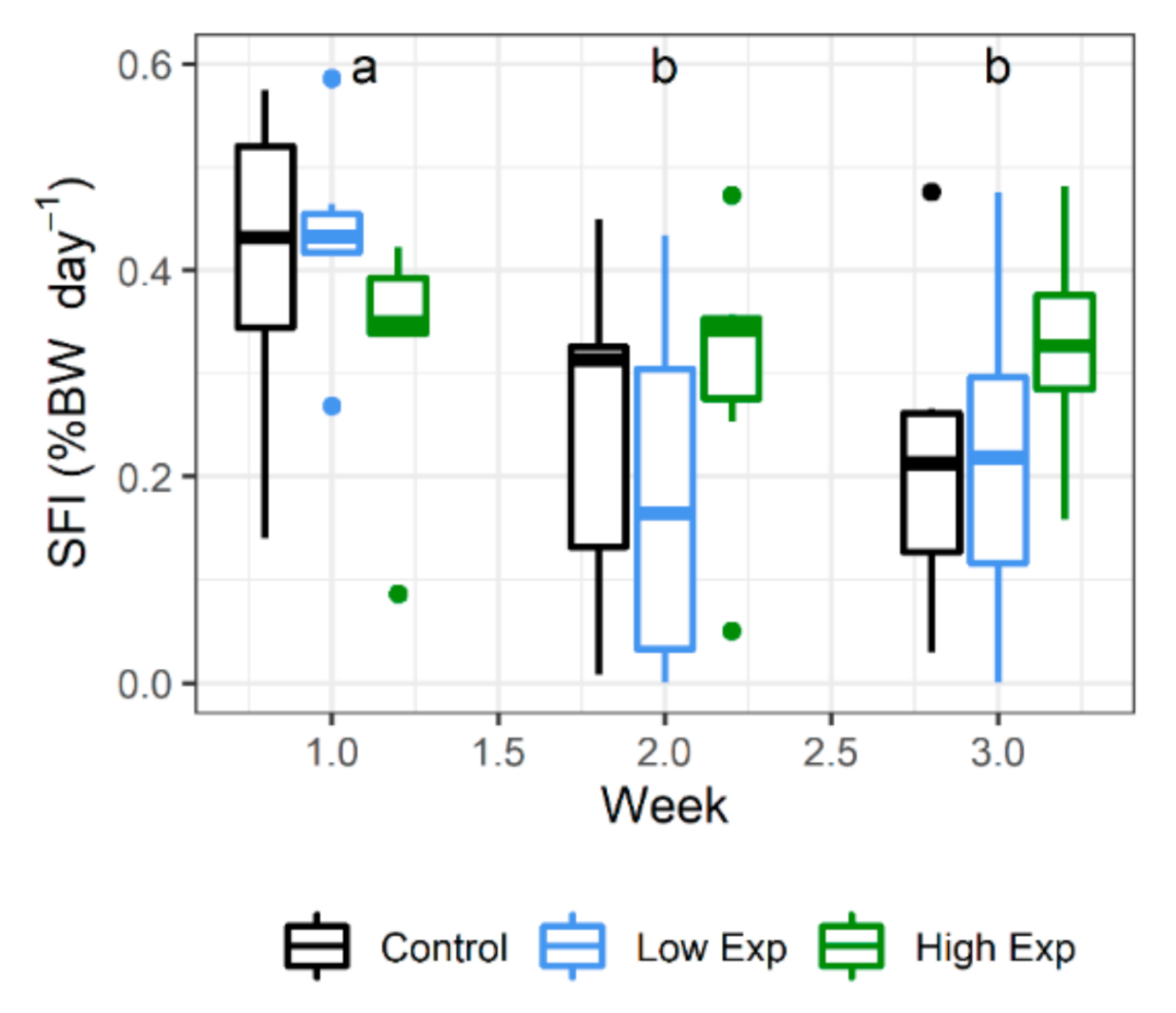
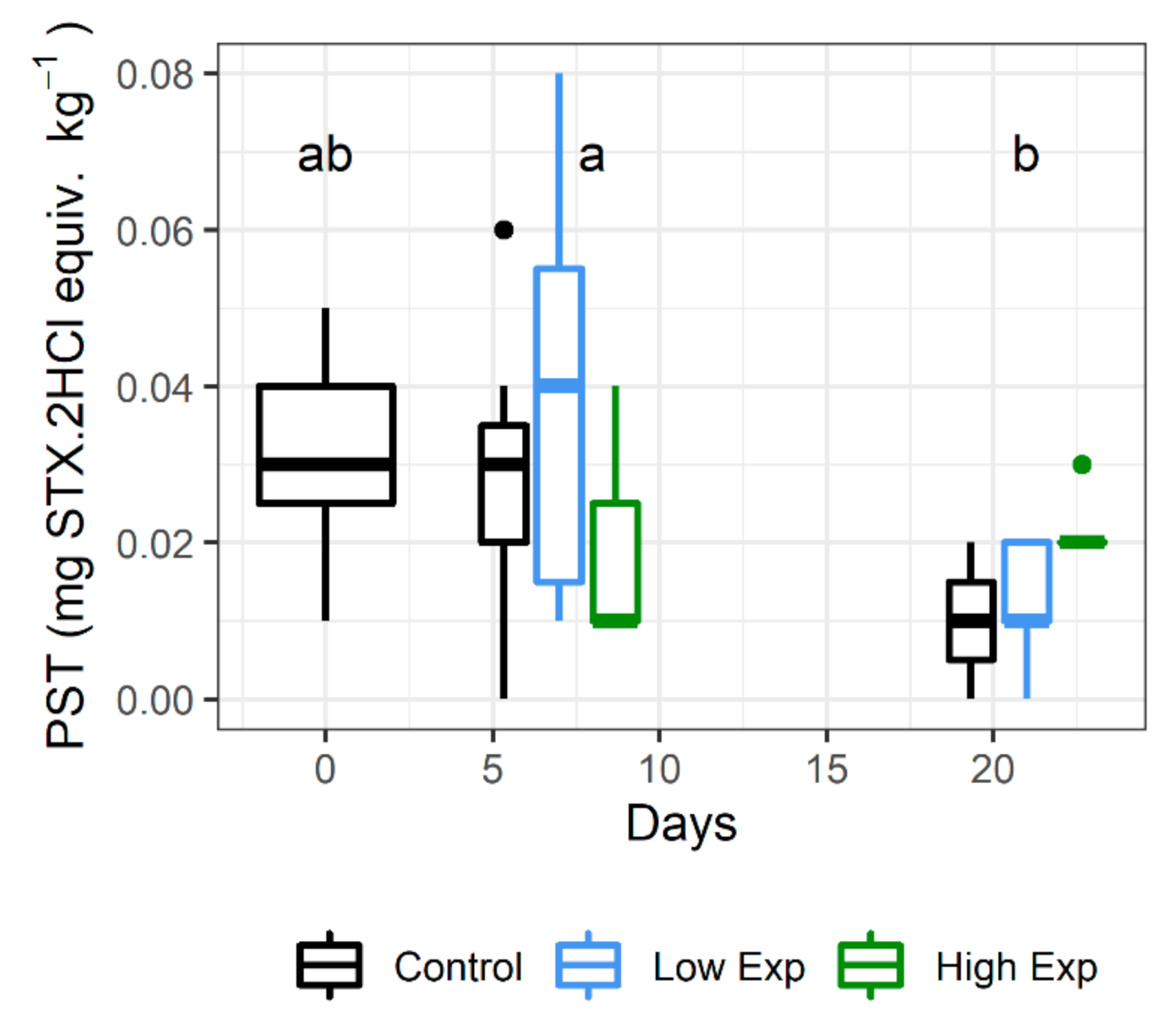
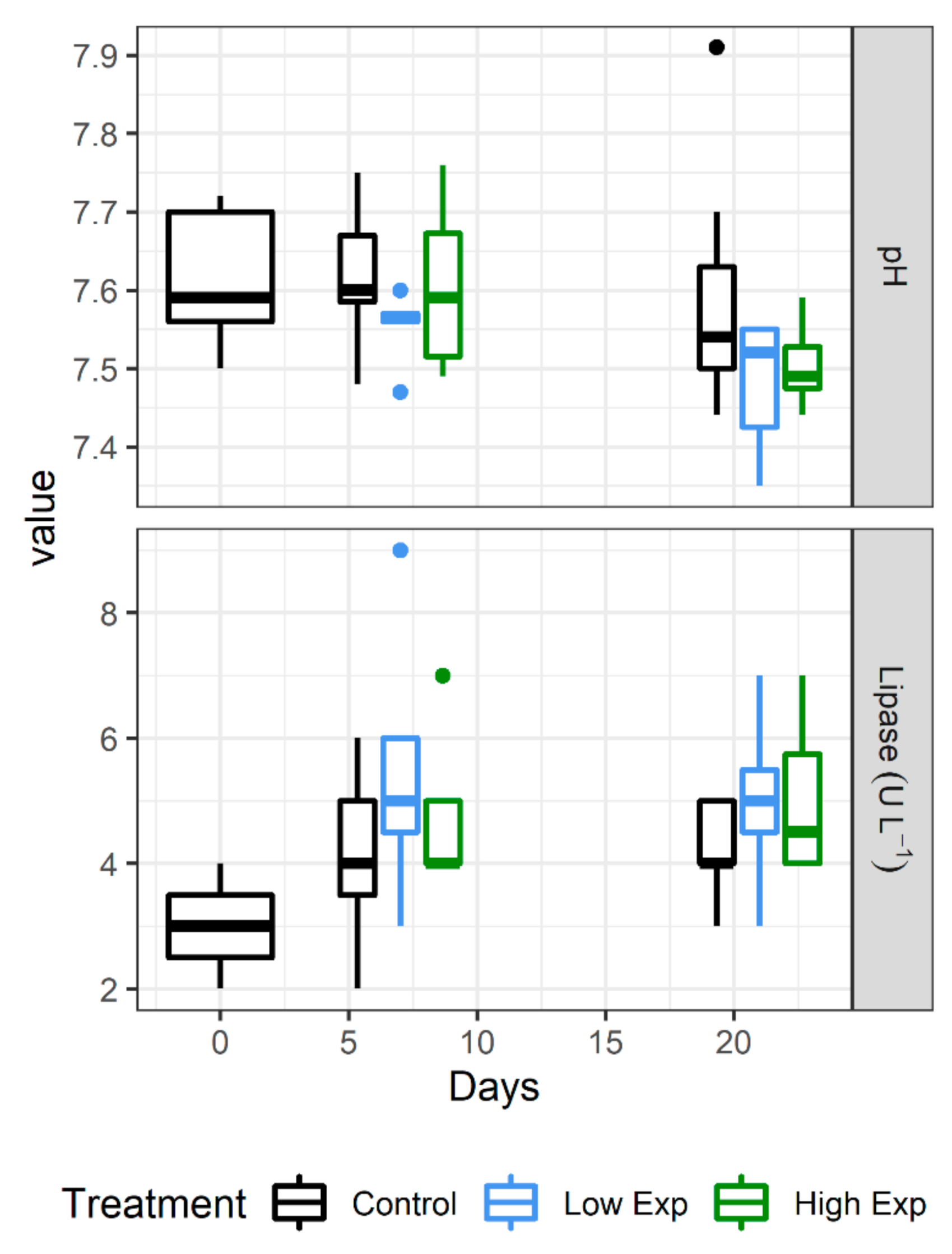

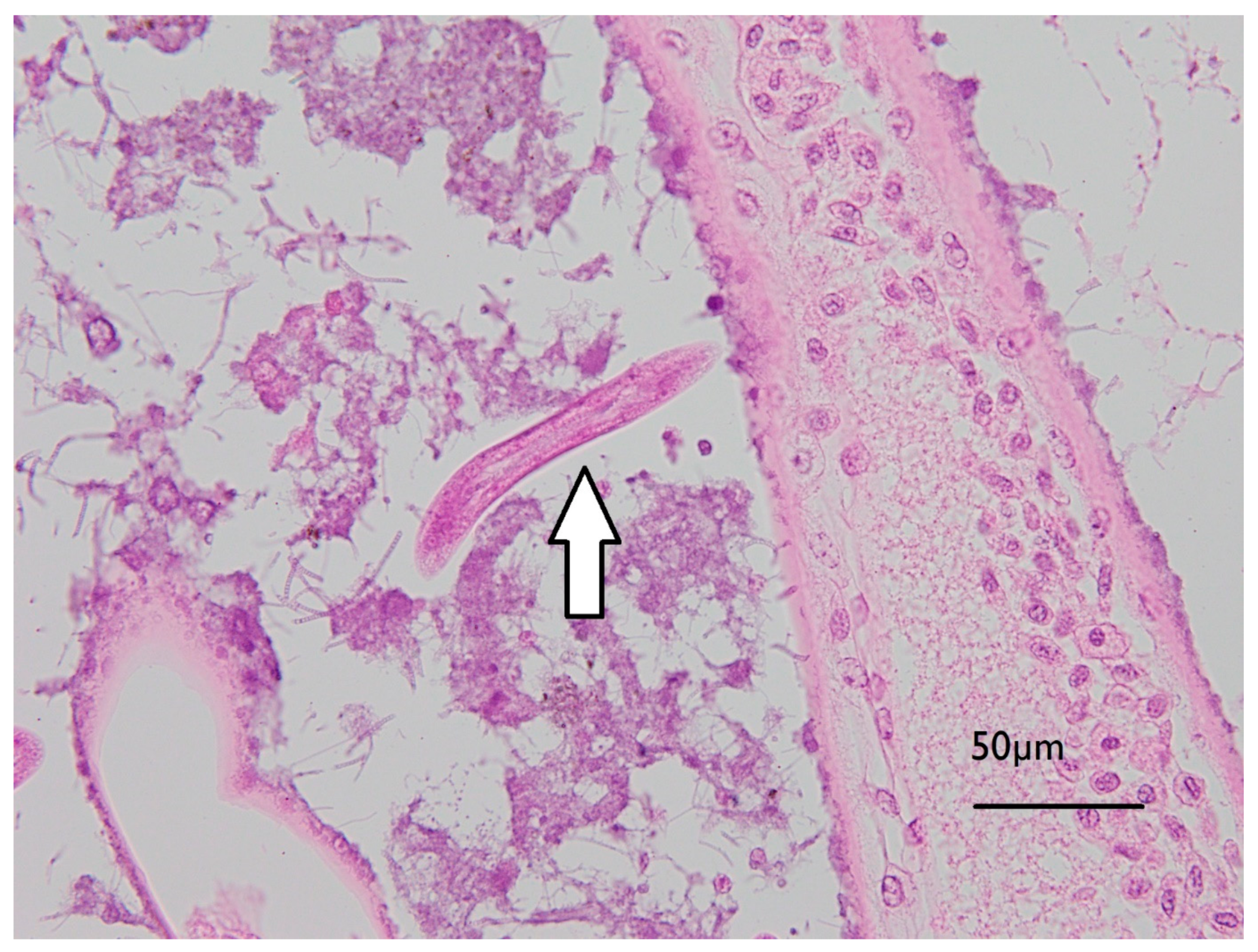
| Variable | Treatment | Days | Treatment: Days | Two-Way ANOVA, OLR, or LR |
|---|---|---|---|---|
| Behaviour | ||||
| Vitality | NS | |||
| Time to right | NS | |||
| Reflex Impairment Score (RIS) | NS, vitality and RIS sig. related (p < 0.001) | |||
| Specific feed intake | *** | F = 12.3, week 1 higher than weeks 2 and 3 | ||
| Immune Response | ||||
| Haemocyte count | *** | F = 18.0, weeks 1 and 2 lower than week 3 | ||
| Bacteraemia on ZMA media | NS | |||
| Bacteraemia on TCBS media | NS | |||
| Necrosis | NS | |||
| Nutritional | ||||
| Hepatopancreas Index | NS | |||
| Brix | NS | |||
| Hemolymph/Biochemical | ||||
| pH | * | F = 4.0, control higher than low exp treatment | ||
| Sodium | NS | |||
| Potassium | NS | |||
| Sodium:potassium | NS | |||
| Chloride | NS | |||
| Magnesium | NS | |||
| Bicarbonate | NS | |||
| Calcium | NS | |||
| Phosphorus | NS | |||
| Glucose | NS | |||
| Lactate | NS | |||
| Cholesterol | *** | F = 8.8, week 1 lower than week 3 | ||
| Triglyceride | * | * | F = 7.2 (days), week 1 lower than week 3F = 3.5 (treatment:days) | |
| Total protein | * | F = 4.9, week 1 lower than week 3 | ||
| Albumin | NS | |||
| Globulin | NS | |||
| Albumin:globulin | NS | |||
| Uric acid | NS | |||
| Lipase | ** | F = 7.4, control is lower than both exposed treatments | ||
| Glutamate dehydrogenase | NS | |||
| Measured osmolality | NS |
Publisher’s Note: MDPI stays neutral with regard to jurisdictional claims in published maps and institutional affiliations. |
© 2021 by the authors. Licensee MDPI, Basel, Switzerland. This article is an open access article distributed under the terms and conditions of the Creative Commons Attribution (CC BY) license (http://creativecommons.org/licenses/by/4.0/).
Share and Cite
Turnbull, A.; Seger, A.; Jolley, J.; Hallegraeff, G.; Knowles, G.; Fitzgibbon, Q. Lobster Supply Chains Are Not at Risk from Paralytic Shellfish Toxin Accumulation during Wet Storage. Toxins 2021, 13, 129. https://doi.org/10.3390/toxins13020129
Turnbull A, Seger A, Jolley J, Hallegraeff G, Knowles G, Fitzgibbon Q. Lobster Supply Chains Are Not at Risk from Paralytic Shellfish Toxin Accumulation during Wet Storage. Toxins. 2021; 13(2):129. https://doi.org/10.3390/toxins13020129
Chicago/Turabian StyleTurnbull, Alison, Andreas Seger, Jessica Jolley, Gustaaf Hallegraeff, Graeme Knowles, and Quinn Fitzgibbon. 2021. "Lobster Supply Chains Are Not at Risk from Paralytic Shellfish Toxin Accumulation during Wet Storage" Toxins 13, no. 2: 129. https://doi.org/10.3390/toxins13020129
APA StyleTurnbull, A., Seger, A., Jolley, J., Hallegraeff, G., Knowles, G., & Fitzgibbon, Q. (2021). Lobster Supply Chains Are Not at Risk from Paralytic Shellfish Toxin Accumulation during Wet Storage. Toxins, 13(2), 129. https://doi.org/10.3390/toxins13020129





